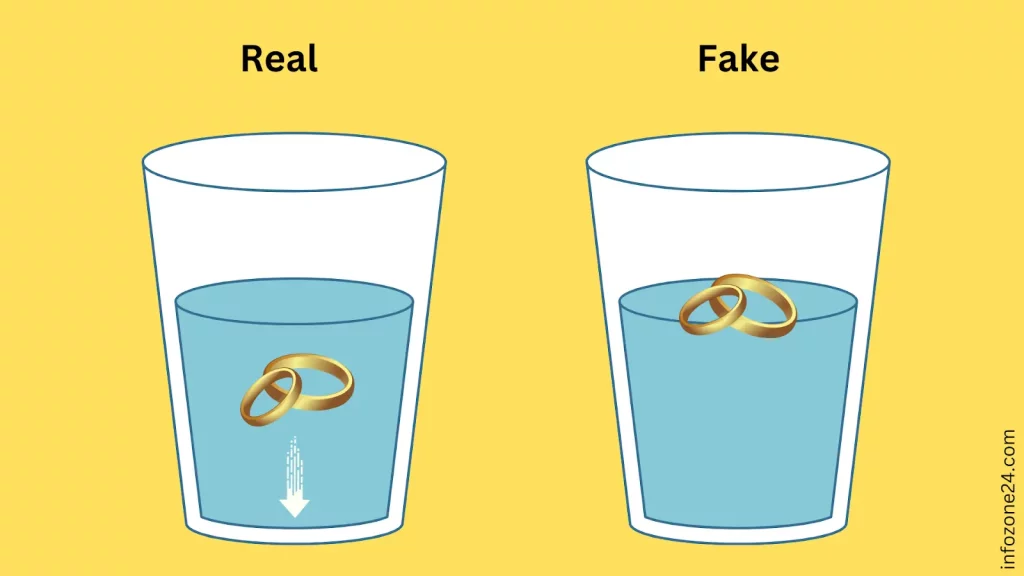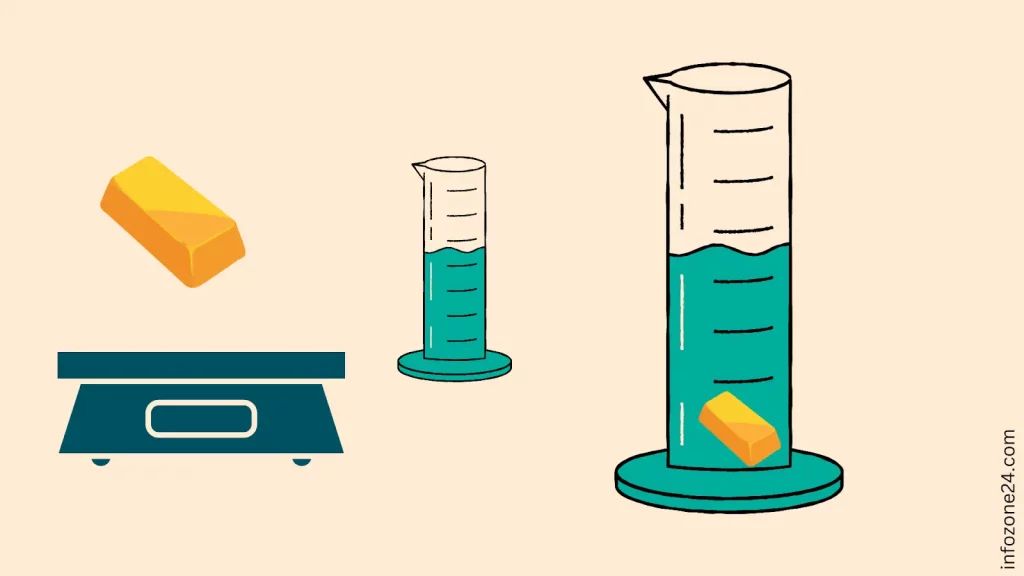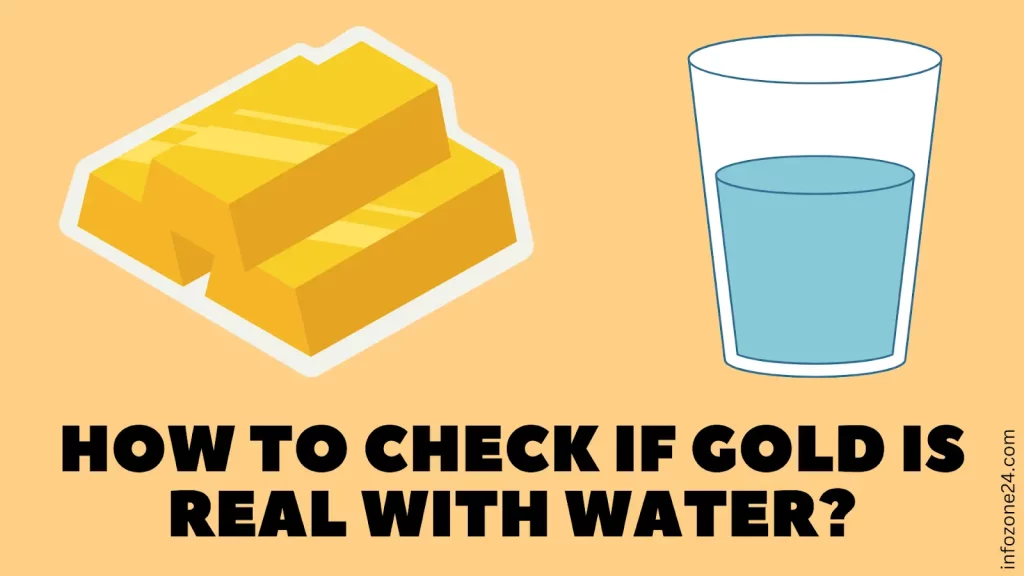Every gold looks the same to an amateur eye. But not all of them are genuine gold. If you’re suspecting the authenticity of your gold, there are many tests to spot fake gold. The water test is one of the ways to tell if gold is fake. In this article, we will explain how to check if gold is real with water. You can easily tell whether or not your gold is real or fake.
How To Tell If Gold Is Real With Water?
Do you know how to tell if your gold is real using water? Unlike other tests, the water test is a 100% non-destructive gold test. Some other tests may leave your gold with stains. Some may even destroy the gold piece entirely. However, the water test is one of the best ways to test gold at home. If you don’t want to damage your gold piece, this is the way to go. You can test your gold coins or gold bullion and tell if your gold is real.
The water test has two types:
- The Float Test
- The Water Displacement Test
Let’s discuss both experiments in detail.
The Float Test:

Do you want to determine your gold’s authenticity? This is a simple and easy method to test if gold is real.
What You Need:
- A jug or container
- Water
- Piece of gold in question
Procedure:
You can perform the float test in the following two easy steps.
- Fill the jug or container approximately half full with water.
- Take your gold and carefully drop it into the water container.
Results:
If the gold floats, the gold isn’t real. If the gold sinks, you have authentic gold.
Note: Imitation gold may hover in the middle of the container.
Tips:
- Use a jug or container big enough to hold both the water and the gold in question.
- The temperature of the water doesn’t affect this test. So, normal tap water is fine.
Why Does This Work?
Gold is one of the densest metals on Earth. When dropped into water, gold doesn’t float. Its high density makes gold fall directly to the bottom of the container. Real gold has a density of 19.32 grams per cubic centimeter. And that’s the density of 24 karats of gold.
On the other hand, artificial gold is lighter and doesn’t fall directly to the bottom of the container. It floats. Moreover, gold also doesn’t tarnish while it is wet. If you see any discoloration, your gold jewelry is probably gold plated.
Keep Reading: How To Check If Gold Is Real With Vinegar?
Limitations to the Float Test:
Some imitation gold items are made of heavy metals. They may not float or sink slowly. If you are not satisfied with this test, you can perform other tests to see whether your item is real or fake.
The Water Displacement Test / Density Test:

This great test is also known as the density test. It has been around for a very long time. In this test, you need to find the density of gold. This is done by immersing the gold in water and measuring the water displacement. We calculate the density of gold with the measurement of water displacement. This is one of the oldest methods of testing gold.
What You Need
- Kitchen Scale
- Graduated cylinder
- Water
- Calculator
- Gold in question
Procedure:
Although this test is quite straightforward, it requires expert care. You need to be very careful while performing this test.
Here are the steps you should follow:
- Measure the weight of your gold item on the scale. Record it in grams.
- Fill the graduated cylinder half with water.
- Carefully record the water level in cubic centimeters (cc).
- Let this initial volume reading be referred to as V1.
- Now, take your gold item and gently drop the gold piece into the cylinder.
- Make sure the water doesn’t splash while you drop the gold piece.
- Now, record the water level again after the gold piece is immersed in water.
- Let this new reading be referred to as V2.
- Calculate the difference (V2 – V1) between both volume readings.
- Divide the weight of the gold piece object by V2-V1 to yield the density of the gold piece in question.
- Density = Weight of the Gold Piece/ V2 – V1
- Now, compare the measured density to the density of pure gold (19.3 grams per cubic centimeter).
Keep Reading: How To Check If Gold Is Real With A Magnet?
Results:
As mentioned earlier, pure gold has a density of 19.3 grams per cubic centimeter.
- If your measured density result doesn’t match, it’s fake.
- If your measured result is exactly 19.3 g/cm3 or close, it’s real.
Tips:
- Milliliter (ml) markings are common on the graduated cylinder. 1 milliliter (ml) is equal to 1 cubic centimeter (cc).
- You must carefully lower the gold piece into the cylinder, so water doesn’t splash. Otherwise, you might have an incorrect reading.
- You must perform this test with a water temperature of exactly 20° Celsius.
Why Does This Work?
24k gold items are made entirely of gold. 24-karat gold is pure gold with 999.9/1000 fineness. Its density is 19.3 g/cm3. It has the maximum percentage of gold. If the density of your gold piece matches, your gold piece is real. And if your gold piece comes out to be real, you can also get to know about its fineness. This test is a quite good way to see if your gold item is made of real or fake gold.
Limitations to the Water Displacement Test:
Some counterfeited gold alloys may pass this test. It is possible to combine some metals to yield a density the same as that of real gold. If your measured density matches, we recommend making further analysis. You may also take it to a professional.
Conclusion:
So, both types of water tests are easy and quick. If you want to check your gold right at home, this is the way to go. Especially if you want to avoid the risk of getting your piece damaged. Moreover, your precious gold items will not be impaired at all. The water test isn’t foolproof. If you are not satisfied with them, there are other ways to test your gold. Like magnet test, acid test, skin test, etc. You can always refer to a professional to check if your item is made of real gold.
Read Now: How to Check If Gold is Real With a Lighter & 18 Other Methods
Michael C Vang is a passionate blogger. He has been blogging since 2013 on a variety of topics. He is committed to creating informative and engaging content that helps readers learn more about everything.



